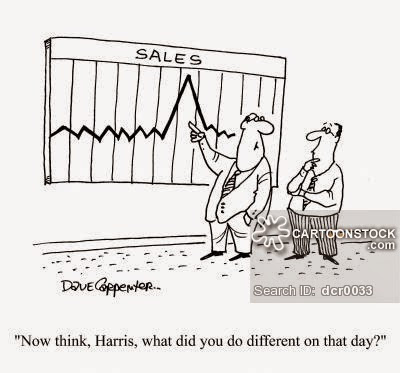Just like a medical healthcheck has various indicators like heart rate, blood pressure, cholesterol levels etc, Financial Ratios are the indicators for a company or business. Ratios tell us whether the company or business is in great health or has critical health issues.
It also gives us a better overview of how the company or business is actually performing. In short, it helps us see the "Bigger Picture".
Great! So, where do I start?
Your starting point is knowing what Financial Ratios are, how to calculate the Ratios and what 'stories' these Ratios tell us.
The beauty of it is - All the figures required for calculating these ratios can be found inside the 'BIG 3' Financial Statements - The Balance Sheet, The Profit And Loss Statement and The Cash Flow Statement!
Tell me! Tell me! What are these "Ratios"?
Financial Ratios can be divided into 4 broad categories. These categories are presented below, together with the Ratios that sit within them. The purpose of each Ratio is then explained.
Liquidity & Solvency Ratios
Current Ratio
Current Ratio = Current Assets / Current Liabilities
It shows the company's ability to meet its short-term obligations. The higher the ratio, the better.
Quick Ratio
Quick Ratio = (Current Assets - Inventory) / Current Liabilities
Similar to the Current Ratio. It shows the company's ability to meet its short-term obligations but using its most 'liquid' assets (i.e. near cash or quick assets, excluding inventory which usually takes longer to be converted into cash). The higher the ratio, the better.
Wow! That was quick!
Debt To Equity Ratio
Debt To Equity Ratio = Total Liabilities / Shareholders' Equity
It shows how the company is funded i.e. by Debt or by Equity and used as a standard for judging a company's financial standing. Too much debt may be a problem as it ties the company to interest payments and repayment of its loans and borrowings. A good balance of Debt and Equity is recommended.
Debt Ratio
Debt Ratio = Total Liabilities / Total Assets
Similar to the Debt To Equity Ratio. It shows how much the company relies on Debt to finance its Assets. The lower the ratio, the better.
Interest Coverage Ratio
Interest Coverage Ratio = Operating Profit / Interest Expense
It shows how easily a company can pay interest on outstanding Debts (i.e. loans and borrowings). The higher the ratio, the better.
Efficiency Ratios
Days Sales Outstanding (DSO)
DSO = Trade Receivables / Revenue x 365
It shows how many days a company takes to collect cash from customers, after a sale has been made. The lower the number of days, the better.
Days Inventory Outstanding (DIO)
DIO = Inventory / Cost of Goods Sold x 365
It shows how many days a company takes to sell its inventory. The lower the number of days, the better.
Days Payables Outstanding (DPO)
DPO = Trade Payables / Cost of Goods Sold x 365
It shows how many days a company takes to pay its suppliers. The higher the number of days, the better.
Cash Conversion Cycle (CCC)
CCC = DIO + DSO - DPO
It shows the combined effectiveness of the company to collect cash from customers, convert inventory into cash and to pay its suppliers. The lower the number of days, the better.
Profitability Ratios
Revenue Growth
Revenue Growth = Current period Revenue / Prior period Revenue
It shows how much revenue has grown in the current period compared to the prior period. The higher the ratio, the better.

Return On Assets
Return On Assets = Net Income / Total Assets
It shows how effective the company is at using its assets to generate profits. The higher the ratio, the better.
Return On Equity
Return On Equity = Net Income / Shareholders' Equity
It shows how effective the company is at using the money invested by shareholders to generate profits. The higher the ratio, the better.
Net Profit Margin
Net Profit Margin = Net Income / Revenue
It shows how much each dollar of revenue earned is translated into profits. The higher the ratio, the better.
Cash Flow Ratios
Operating Cash Flow
Operating Cash Flow = Cash Flows From Operating Activities / Revenue
It shows how many dollars of cash you get for every dollar of sales. The higher the ratio, the better.
Asset Efficiency
Asset Efficiency = Cash Flows From Operating Activities / Total Assets
It shows how well the company uses its assets to generate cash flow. The higher the ratio, the better.
Cash Generating Power
Cash Generating Power = Cash Flows From Operating Activities / [Cash Flows From Operating Activities + Cash Flows From Investing Activities (Total of inflows only) +
Cash Flows From Financing Activities (Total of inflows only)]
This is a complex ratio but probably one of the most powerful, hence its name!
It shows the company’s ability to generate cash purely from operations compared to the total cash inflow (i.e. ignoring cash outflows).
Note that instead of using both cash inflows and outflows
from Investing activities and from Financing activities, only cash inflows are used. Cash outflows are excluded. The higher the ratio, the better.
On that note, let's take you back to the 90's with a song called "The Power" by Snap!
Enjoy!






No comments:
Post a Comment